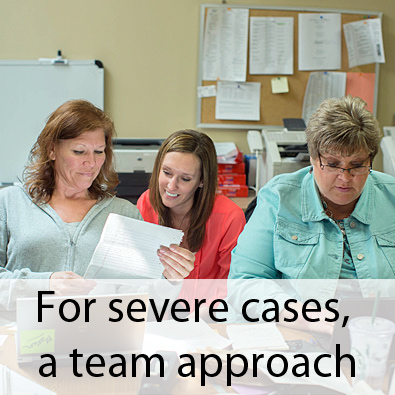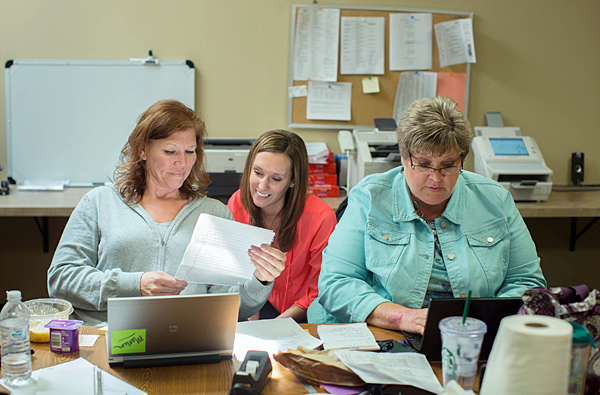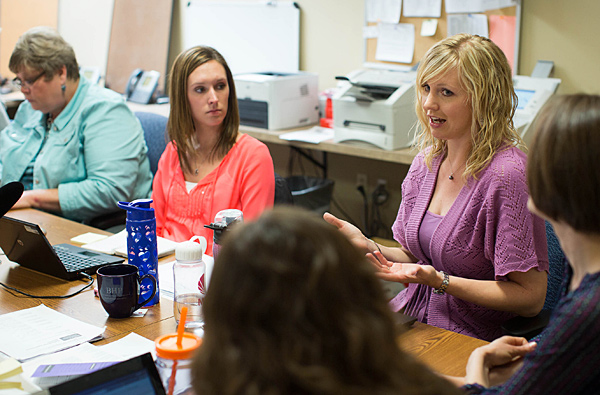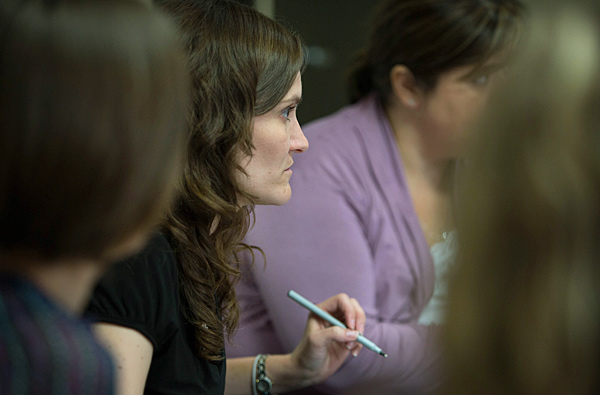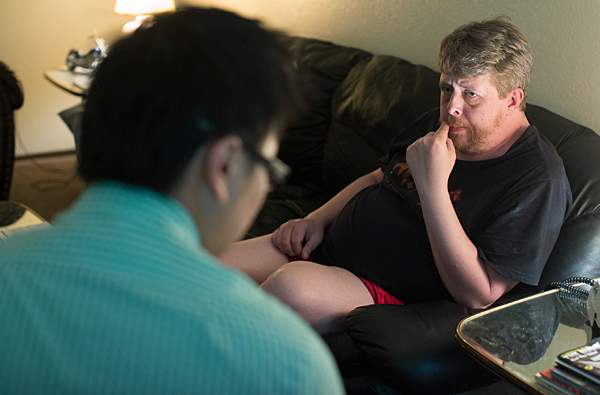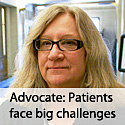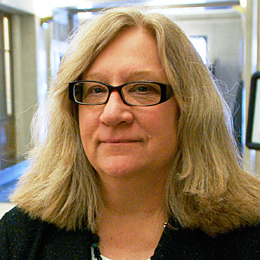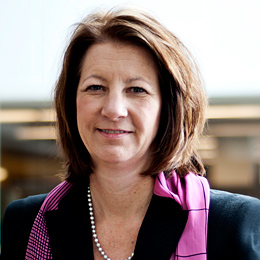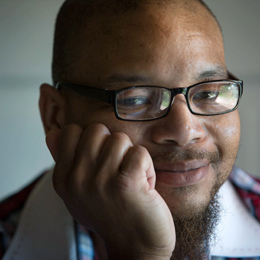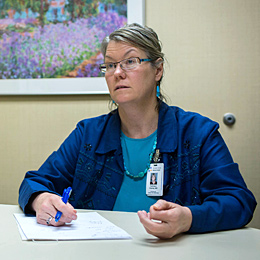Minnesota's Mental State
July, 2013
More than 220,000 people receive mental health services from the state of Minnesota. These safety net mental health services are often all that stand between mentally ill people and life on the street or worse. This special report, produced by MPR's All Things Considered, takes you inside the state's mental health services for perspectives on what's working and the parts that are often overwhelmed. We found that with proper diagnosis, treatment, and support, people with mental illness can gain control of their symptoms, and go on with their lives.
For severe mental health cases, a team approach
On a recent morning, members of the Ramsey Assertive Community Treatment team pull up to a table to discuss some of their 95 clients.
"She hasn't been hearing the voices," one the team members says of a woman under its care. "Listening to music helps with the voices because when she repeats the lyrics it helps distract the voices. She looks really good."
Meetings like this one offer hope for the approximately 2,000 severely mentally ill people in Minnesota who are living at home. It could help allow some people with severe mental illness to disprove the stigma that surround their diagnoses: that they cannot regain that ability to lead normal lives or that they will someday have to be committed to a hospital or treatment facility.
The Ramsey County team's 13 members, who include psychiatrists, nurses, social workers, vocational specialists and chemical health specialists, want to ensure that no significant detail in a client's treatment is missed.
A 'HOSPITAL ON WHEELS'
More than 220,000 people received mental health services from the state of Minnesota in 2010, according to the latest data available. The team approach, reserved for clients with the most severe mental illnesses who are able to live at home, has proven so successful that state officials are evaluating how a modified ACT team approach could help clients in prisons, and people in remote areas of the state.
"We're essentially a hospital on wheels," says Bria Grudzielanek, Ramsey County team leader. "We're able to go out into the community and see people, so we do provide the most intensive level of service next to hospitalization."
The ACT team's hourlong meeting offers a chance for mental health and other professionals to provide their colleagues with an update on every client they've visited in the past 24 hours. They work with people who have been diagnosed with long-running mental illnesses, among them schizophrenia, depression, personality disorders and bipolar disorder.
Some clients hear voices, who think their neighbors are plotting against them or who are afraid to go out in public. Some are thinking about suicide.
All of the team's clients have been in treatment through other programs, but they've been referred to the ACT team because they need more intense supervision to make those treatments stick.
CLIENT-CENTERED TREATMENT
Grudzielanek's team discusses clients every day. That's what makes its members effective, she says. But more important, she says, is how the team works with each of its clients to develop a "client-centered" treatment plan.
"We're not here to tell you what to do," she said. "We're really here to help you and support you and you get to define what that support is going to look like for you."
Practically, that means clients can live in the community — whether independently or in assisted-living situation — and determine their own goals. It may sound simple to some, but symptoms like paranoia or extreme anxiety — and circumstances such as homelessness and chemical dependency — can interfere with a client's progress.
Once a client identifies a goal, the team assists in any way possible so the person can achieve it. For example, a client who is afraid to go out in public might set a goal of going to a Twins baseball game, something many would take for granted. That means the team will help the person learn to do things like getting to the ballpark.
"What we're going to be doing is practicing riding the bus so he can get used to the bus route there and know how to get there, practice using some de-escalation techniques, things to help reduce the anxiety so he can enjoy the game when he's there," Grudzielanek says. "And we're also working with him on walking, because he wants to build up his stamina so to be able to walk around the stadium when he's there."
The need for clients to exercise comes up a lot in the team meetings. Studies have shown a connection between physical health and mental health, so ACT team members make it a point to encourage clients to exercise when that fits into their goals. It's all a part of getting clients to "own" their health — to avoid the crises that can arise when symptoms get bad.
"We definitely are here to respond to crises when they happen, because they do happen," Grudzielanek says. "We're working with people who have really severe illnesses. But our goal is to prevent those crises. So helping people recognize possible triggers or stressors and being able to deal with those before they get to a crises situation."
GOAL: KEEP PATIENTS OUT OF THE HOSPITAL
There are 26 assertive community treatment teams in Minnesota, spread almost evenly between the Twin Cities metro area and the rest of the state. Those services cost about $12,000 per client per year — a tab largely paid through medical assistance or insurance. For clients who don't qualify, counties will pick up the cost.
ACT teams started in the 1970s, sparked by a movement to move patients from institutions. From the start, members of such teams have aimed to treat people with what are considered severe, long-term mental illnesses in their communities.
The goal from a treatment perspective is to keep patients out of the hospital. Given that the cost of keeping a patient in the hospital is thousands of dollars a day, Grudzielanek said it's a good deal.
"We are intensive; we are available 24-7," she says. "So we always have someone on call, we work weekends, we work holidays. But it is still better to have this than someone go in the hospital and get 24-hour care and pay for that. "
After the team's daily meeting wraps up, the real work begins — work that inevitably involves a lot of driving.
"In a year I probably put [in] 40,000 miles or more," team member Yer Lee says with a laugh. "I stopped counting."
Lee, a social worker and vocational specialist, is often out of the office, meeting with employers who are willing to consider hiring ACT team clients, and helping clients find work.
ONE CLIENT'S STORY
On a recent appointment, he met with Kris O'Leary, a client who has a strong desire to work. They've met each week for about an hour or so to work on job applications, online job searches and interviewing skills. Lee also helps his client make phone calls and arrange follow-up conversations with potential employers.
O'Leary was diagnosed 12 years ago with paranoid schizophrenia after experiencing auditory hallucinations. He believed he was possessed, that his house was haunted. That confusion and fear led him to crisis. He was committed and spent time in a state hospital and group home before beginning with the Ramsey ACT team in 2009.
Working with the team, O'Leary said, brought some stability to his life.
"They showed me the correct path and how to handle my mental illness better with medication," he said. "I've been on a couple bad medications — one gave me fainting spells and the other one made it so I couldn't sit still. ... It's been going okay. I haven't had an episode of paranoia in awhile."
Now 37, O'Leary is doing well on his medication. He manages a bank account, works out at a gym, and — with help from a housing assistance program similar to Section 8 — he's been renting a small spare apartment on St. Paul's East Side. It has the hallmarks of a bachelor pad: ashtrays, skulls for decoration and rock posters on the wall. On a recent visit, he wore a T-shirt with the band AC/DC's logo on the front.
Despite a consistent work history before his diagnosis and numerous job applications, O'Leary hasn't been able to get past the interview stage over the past few months. With that in mind, he and Lee have decided to try some practice interviews. Lee plays the role of a hiring manager at Subway.
After they wrap up, Lee asks O'Leary how he thinks he can improve.
"Just be more confident when I go in there with my answers, not waste all this time thinking about an answer," O'Leary says. "Just boom, boom, boom."
"How do you think you can change your confidence, though?" Lee asks.
"Getting a job," O'Leary replies with a laugh.
"Like with the interview itself? Because you said you don't have a lot of confidence in the interview," Lee says.
"Expect the questions."
PROGRESS IS THE POINT
When O'Leary finally lands a job, he will give Lee the green light to check in with his employer about how he's doing. It's that ongoing connection that he feels increases his odds of getting where he wants to be.
"Now I'm at a place where I'm living by myself, and the only person I really have to rely on is myself," he said. "The ACT team members, they show up every once in awhile: once a week, twice a week. But pretty much it's me on my own, fending for myself."
"I'd like to get a job, save up for a car, and take myself to school, college," he said. "I'd like to move on from this part of my life. Not really forget about it, just learn from it. Look back on it, say, 'I was there, that happened to me, and I dealt with it.' Progression, you know? Progress."
Grudzielanek, the ACT team leader, agrees with O'Leary that "progress" is the point.
"Ultimately we want to work ourselves out of a job where people do not need us anymore," she said. "So a lot of what we're doing is teaching skills to people, helping them learn to manage their symptoms, to be able to stay in the community — to be able to live in an apartment, to be able to interact with others, be able to work or go to school, and do the things that they want to do."
On average, Grudzielanek said about once a month a client graduates, or "steps down" to a less intensive program. But there also are disappointments. A number of clients have died from their illnesses, or from other medical problems.
For the team's members, sometimes success is just keeping clients alive and functioning, and achieving small victories.
"You were able to get a job, or you made it to this class, or you joined the Y, you were able to communicate with your partner," Grudzielanek said of the small successes that can help clients.
"Just things that, being able to highlight those strengths and seeing them recognize, 'Wow, I did learn a lot, I did do a lot these past six months' is super exciting. People get better. That's one of the best things, that people do recover from mental illness. That they're able to live the lives that they want to live."
-
This map shows what each state spent on mental health care per capita in fiscal year 2010. Minnesota ranked at #15 that year, according to data collected by the Kaiser Family Foundation.
-
As the state of Minnesota continues to emphasize community-based resources mental health treatment, opposed to more institutional regional treatment centers like the state-run facility in St. Peter, total state spending on mental health care has risen steadily over the last decade. Community-based treatments cost more, but are more effective and less stigmatizing than institutionalization.
-
The trend is similar for children's mental health services.
Mental health care, by the numbers
Graphics, map by Nathaniel Minor
Advocate: The challenges mental health patients face
By Tom Crann
Advocates say the stigma surrounding mental illness is still a top concern for mental health care in the state of Minnesota.
Sue Abderholden, the executive director of the National Alliance on Mental Illness (NAMI), said the stigma leads to discrimination and other issues.
She recently sat down with MPR's Tom Crann to discuss that, and other challenges facing people with mental health issues.
Below is a transcript of their conversation, edited for length and clarity.
SUE ABDERHOLDEN: There is unfortunately still a stigma surrounding mental illness and the real problem with stigma is that leads to discrimination, hopelessness, and people not seeking help when they should. I think the second thing is access, both in terms of your insurance covering mental health treatment as it should, as it would any other illness and being able to access the specialists that you need when you need them. And then the third is just the community support that should be available to people who live with a mental illness and their families, it isn't [there].
One of the most striking things I discovered when I first came to NAMI is I talked to adults who lived with a serious mental illness, I would ask them, "When you were hospitalized, did you ever receive a 'get well' card?" and pretty much 100 percent said no. And so, you know, you don't get that community support, that hope that you're going to get better, that support along that journey. The families don't get hot dishes or meals brought to them. And so the community is really not supporting people on what can be a very difficult journey.
CRANN: How has the mental health parity law passed in 2008 changed things and what still hasn't changed?
ABDERHOLDEN: Well, unfortunately the federal mental health parity regulations have not been issued so I can say that we're really not sure yet what the impact of that will be.
CRANN: So that strictly means the law's been passed but there aren't guidelines from the federal government about how to achieve what the law sets out to do.
ABDERHOLDEN: Correct. I think the biggest change that's going to happen to the mental health world is Minnesota's health care exchange, MNsure. I think what people don't realize is that mental health parity just says if you cover mental health and substance use disorder treatment then you have to cover it in the same way. It doesn't require you to cover it. And most individual policies and small group policies actually don't cover it. Any policy covered offered under the health care exchange, under MNsure not only has to cover federal parity guidelines, they actually have to cover mental health and substance use disorder treatment. So we actually think that this is going to be a big boon to our mental health system because people will actually have insurance that will pay for the treatment they need.
CRANN: You see this as a big victory for children's mental health care. Why?
ABDERHOLDEN: Well, it was a very good year for children's mental health. And the reason we focused on children's mental health this year is because half of all adults who live with a serious mental illness began experiencing symptoms before the age of 14. And most everyone else, I mean a huge percentage, those illnesses come out before the age of 26. So if we wait until people are adults, we've waited too long.
The tragedies at Accent Signage and at Sandy Hook Elementary really culminated in a discussion about what should we do about the children's mental health system. So we really had 12 different bills that were introduced, almost 29 different provisions, and 17 of them passed. And I have to say that with so much discussion in January, February, and even March about, "We need to do something about the mental health system." When we finally did and got a lot of things passed, you could have heard a pin drop because nobody was talking about it. And that actually is kind of upsetting to me because when we do make progress, we actually need to celebrate those things.
CRANN: Mental health has been getting a lot of attention in this past six months. And certainly it has been tied into the arguments we've seen about gun control. What do you think when you hear it?
ABDERHOLDEN: Well, I'm really saddened when I hear that, because it just feeds into the fear surrounding people with mental illnesses. Mental illness and violence really are not inextricably linked; they just aren't. There's a small percentage, generally related to people not accessing treatment, and not understanding that they're ill, which is sometimes part of a mental illness. What we don't talk about really hardly ever are the recovery stories: how people can get better, what treatments work. We never cover that piece. So if we keep tying mental illness and violence together, we will continue, frankly, to shroud it in secrecy and in stigma.
CRANN: What do you think the biggest misconception out there about people with mental illness is? The one that's doing the most harm, perhaps.
ABDERHOLDEN: I think the biggest misperception is that people can't get better, that they can't have full lives in the community. We like to talk about recovery frankly as a home, a job, and a date on a Saturday night. It isn't enough to just take a pill, it isn't enough just to have therapy. It's really more than that. We all need a reason to get up in the morning, we all need to have family and friends be a part of our lives. It's really a broader view than just a lack of symptoms, it has be more than that. And people can have very, very full lives.
MPR File Photo/Tim Post
DHS head: How state care is evolving
By Tom Crann
The state Department of Human Services manages the safety net resources for more than 220,000 Minnesotans with mental health diagnoses. Commisssioner Lucinda Jesson says that costs about $1 billion a year.
Jesson who was appointed to lead the DHS in 2011, recently spoke with MPR's Tom Crann. She acknowledged that there are some major gaps in the state's mental health system, and touched on some recent changes.
Below is a transcript of their conversation, edited for length and clarity.
LUCINDA JESSON: On any given day we have about 100 children and 50 adults with complex mental health needs, sometimes with aggressive behaviors that do not have the community supports they need. Those people do not belong in the hospital, but they need more supports to be able to remain in the community and that's a challenge that we still need to address going forward.
TOM CRANN: Access to mental health care is important. From one psychiatrist we talked to from Hennepin County Medical Center to our regular medical analyst, our family physician, Dr. John Hallberg and others we've talked to in the series, we've heard there just aren't enough psychiatric care providers — psychiatrists, social workers — to handle the need. And then there's the issue, in rural Minnesota, of distance as well. So what are you at DHS doing so that the state's most vulnerable people don't fall through the cracks?
JESSON: Well, I think the biggest crisis we face in our mental health area, isn't the lack of hospital beds, it's the lack of treatment providers, especially psychiatrists. We know, especially for children, we know we have only approximately 100 certified child psychiatrists in the state of Minnesota. While we are doing a lot to get hundreds of thousands more Minnesotans on public programs so that they'll have insurance, that insurance isn't meaningful unless we have professionals.
CRANN: So what can DHS do to get more professionals in the field?
JESSON: Absolutely. And we made a start on this in this year's budget with the Legislature. The governor proposed, and the Legislature enacted, to put in a lot more dollars in medical education. So that's a lot more dollars to train physicians. We train them here in Minnesota, they're more likely to stay here in Minnesota. So we need to continue to do more things to invest in medical education, especially in rural Minnesota. We started this year, but we need to do more in the future.
NEW APPROACHES
CRANN: We've also been hearing that a community-based team approach like the ACT team is something that makes sense for some people and the intervention at that level really makes a difference in their lives. And I'm wondering would that make sense to roll that out to a wider population in the state?
JESSON: Absolutely. One of the first things I did when I started my job as commissioner is I went and watched an ACT team in action. And what we're doing is instead of sending someone with mental illness to a hospital, we're bringing a lot of those services to the individual and that way they can stay in their home and community and get services that really helps them recover. Because, if you think about it, if a person has to leave their family and their home and go in the hospital for let's say two or three months, they often lose their apartment, they lose their connections. It's much harder for them to recover. This is absolutely something we need to expand because we know it's working.
CRANN: Is it too costly though to roll out on a much larger scale because you have a lot of people working on each patient?
JESSON: Well, let's compare that to the cost of hospitalization. It costs us about $1,000 a day to keep a patient at Anoka Regional Treatment Center. One, we can't only think about dollars. But when we think about dollars we have to realize that if we're keeping people in their homes and communities with the right supports, we're keeping them out of expensive hospitals.
CRANN: Is there something that can be done there without spending a lot more money, and that is just training health providers, training doctors, physicians' assistants in the clinics to let people know that these services are indeed available and get people connected?
JESSON: I think that's one of the things that makes the most sense and that we are working on. We need to integrate our mental health system with our traditional medical system. We need to make sure that our frontline providers — primary care doctors, nurses — know about both mental health and substance abuse, that they do more early prevention and screening. Because if we're able to help people earlier, they're not going to end up in those crisis situations in our emergency rooms.
BREAKING DOWN BARRIERS
CRANN: Has there been a change in the DHS in defining mental and physical health? And have those barriers been broken down to the extent you'd like to see them?
JESSON: We're well on our way to that. We're not there yet. One of the things we're talking about is not just have a health care home but have a behavioral health home. So that for patients with mental illness, their mental health clinic is where they go not just for their mental health needs but for their chronic care conditions, for their physical health needs, as well. I think one of the most troubling numbers I learned as commissioner is that people with serious mental illness live 24 years less on average than their counterparts. And we've got to fix that.
CRANN: How?
JESSON: Well, the first thing is to really integrate our mental health care system with our traditional health care system. These people aren't dying earlier because of suicide rates or their mental illness. They're dying of diabetes, of heart conditions, because we aren't meeting their needs. And we actually in our state have started this 10 by 10 initiative, that says, "We're going to reduce that differential by 10 years, by using our ACT teams and our other services to make sure we get these patients with serious mental illnesses in to see their doctors on a regular basis."
CRANN: The Affordable Care Act is coming, a big complex piece of legislation. How do you see it changing access and availability of mental health services?
JESSON: Well, we are going to have over the next two years, over 200,000 more Minnesotans on our public programs alone, just because we're doing the Medicaid expansion and we're making it easier for people to enroll through MNsure. And a lot of those people will now have the ability to go and see their primary care doctor, to get help and not have to just wait until they're in the emergency room. That's a huge step.
Another thing on the Affordable Care Act that's going to be really important is now chemical dependency treatment is an essential health benefit. So insurers, private insurers, are going to have to provide that. And for people with mental illness, that's going to be another huge step forward. Having said that, all this increased access doesn't mean anything unless we address the shortage of mental health providers in our state.
MPR File Photo/Elliot deBruyn
Links and resources
• National Alliance on Mental Illness of MN
• Mental Health Association of MN
A primary care physician's view
• Primary care's role in mental health treatment
• How doctors diagnose mental illnesses
• The distinction between mental and physical health
NewsCut blog
Primary care's role in mental health treatment
By Tom Crann
Most people in the medical field say there aren't enough mental health providers to go around. That means primary care doctors are often the first people to see a patient experiencing some form of mental illness.
That's true for Dr. Jon Hallberg, All Things Considered's regular medical analyst and family medicine physician. He recently spoke with MPR's Tom Crann.
Below is a transcript of their conversation, edited for length and clarity.
CRANN: Is the primary care clinic often that first — or sometimes the only — point of contact for a patient who may be dealing with mental health issues?
HALLBERG: For those who have health insurance, absolutely. The primary care clinic is where people often will go in, in different parts of the country people may go directly to a psychiatrist or therapist. But for the most part, primary care is where it starts.
CRANN: How commonly in the clinic are you seeing someone with mental health issues?
HALLBERG: All the time. In any given half-day, probably a quarter of my patients have some kind of a mental health issue that's either why they're there or it's part of what's going on, broadly speaking. It's almost hard to believe but the National Institutes of Health say that a quarter of American adults, about 26 percent, can be diagnosed with at least one mental disorder in any given time in a year. As hard as that might be to imagine, I think that bears out in my experience.
CRANN: What kinds of conditions are we talking about?
HALLBERG: It's a huge spectrum of conditions. When we talk about mental health issues or mental illness, people probably think of depression, and certainly there's that. It might be something mild we call dysthymia, kind of an ongoing funk that people are in, or it might be a really severe clinical depression where people literally can't get out of bed. It might be one of the anxiety disorders. It could be just sort of free-floating anxiety or something like obsessive compulsive disorder or bipolar affective disorder. And then there are thought disorders where people don't make sense when spoken to and you know that this might be something like schizophrenia.
CRANN: Do patients think their primary care doctor is going to be able to solve their mental health issues?
HALLBERG: I think they hope we can solve their mental health issues. And I think people come in and — I mean, in the best of all possible worlds we're kind of a one-stop shop. And I think that those of us in primary care like to think we can handle about 90 percent of what comes in the door and I think to some extent that's true. I know my colleagues in rural Minnesota and outstate Minnesota, they're the real deal. They really are handling almost everything. In the cities we tend to refer maybe a little more quickly. Within mental health, thank goodness we actually have tools, we have medications that are very effective most of the time, or much of the time.
CRANN: So like other medical specialties, I may go to a primary care doctor and then be referred to the specialist. It works very similarly if you need to refer somebody to a mental health specialist?
HALLBERG: Yes, exactly. If someone has high blood pressure that despite my best efforts, I simply can't get that blood pressure under control, I'll send that person to a nephrologist or a cardiologist. And if I have a mental health issue that I can't control, I'll refer that person to a psychiatrist.
CRANN: What do you see as the barriers for patients getting the mental health care they need?
HALLBERG: It's a combination of things. When I have somebody in my office and I need to get someone seen, it's hard to find either a therapist or psychiatrist that's taking new patients. Insurance issues always come up. Many people are only taking cash now. Many patients don't have the cash to pay for a visit. I really get the sense that there just aren't enough psychiatrists or psychologists to take care of our folks.
CRANN: Why would that be?
HALLBERG: I think there's a lot of reasons. Like family physicians and pediatricians, psychiatrists are kind of at the bottom of the reimbursement scale so I think there's a little disincentive there. It's really tough work. I think that's a hard thing too. When people come in with mental illness, mental health conditions, by the time they may get to a psychiatrist they often have a lot going on and it's not an easy fix many times. It's challenging, challenging work.
CRANN: A visit to the doctor for any reason can bring its own anxieties. Fear of a diagnosis or additional treatment. How do you separate someone who may just be anxious because of something that's unknown vs. mental illness.
HALLBERG: It's such a fine line to make that distinction. So someone's coming in and they're worried they might have cancer. For very good reasons, they're losing some weight, there's something going on that doesn't feel right. I think we can see that fear in their eyes and you hear it in their voices and you can see it in the way they carry their bodies. That has to be addressed. As we're doing a work-up, getting a CAT scan for example, it would be wrong on my part if I didn't ask, "Are you sleeping? Are you able to get through the day?" And if they're not, we need to address that and perhaps prescribe something that can help them get some sleep.
But other times people are coming in and the anxiety is unknown. It doesn't make sense, but they're having panic attacks out of the clear blue, where they think they're going to die and there's no reason for it. That's really getting more to the mental health side of things.
CRANN: Then there's a stigma. The social stigma of mental illness. How much of that do you still come across in the clinic, where people might be even reluctant to reveal it?
HALLBERG: It still happens. Perhaps there's a bit of an age aspect to this. People who are older recall a time when people were told simply to pull themselves up, snap out of it, pull yourself up by your own bootstraps. Thank goodness that as younger people are coming through the clinic there's just less of that. There's so much more conversation about it. It really gets to this point of the mind-body-spirit. Yes, we have to compartmentalize for diagnostic purposes and treatment purposes. But if you really look at us as just a total package, I think that helps. Certainly seeing a provider that's empathetic, who's comfortable talking about these things, goes a long way to reducing that stigma.
CRANN: When a person comes in with mental health issues do you approach those symptoms any differently than if they come in with any other physical ailment?
HALLBERG: I suppose we think about things — we compartmentalize things naturally. That's how we're trained in western medicine. I'm thinking in terms of heart issues, lung issues, orthopedic issues. In that sense, mental health issues are no different. But at the same time it's so woven into how we're feeling physically. I think it really helps to explain to people — 'Look, the brain is part of the body, we're going to approach it that way.' There are certainly external influences on that in terms of our environment and how we're functioning and what our jobs are and our joy of life and all that kind of stuff, but yet we're still one package, we're still the same being.
CRANN: Is there anything in the way that providers think about this that could help reduce the stigma?
HALLBERG: I think as we're learning more about the brain, we understand the neurochemistry involved. We're starting to now do things like functional MRIs and know what parts of the brain are affected in causing certain conditions. That may be getting away from this idea of even using the word "mental" and using the word "brain" — like "brain disorder." If I treat my kidney one way, or my heart one way , or my lung one way, why are we treating the brain so differently? I think it would be great to shift from "mental illness" to a "brain disorder." I think that more accurately reflects what we're dealing with and I think that would go a long way to destigmatizing some of these problems.
Photo courtesy Dr. Jon Hallberg
How doctors diagnose mental illnesses
By Tom Crann
Doctors say diagnosing mental illnesses involves a lot of guess work, but they have hope that research will make it more precise in the coming years.
MPR's Tom Crann spoke with Dr. Jon Hallberg about how he and other physicians diagnose mental illnesses. Hallberg is a regular medical analyst for All Things Considered.
Below is a transcript of their conversation, edited for length and clarity.
TOM CRANN: Take us into the clinic and how you actually make a diagnosis of mental illness.
HALLBERG: It would be so much easier if there was an actual test, like a strep throat test that we do. It's yes or no. With mental illness it's so much trickier than that. I think it requires a certain understanding of a patient, knowing them. There's a certain storytelling that goes into it. They have to tell you what they're experiencing, so symptoms really, really matter. Someday there will come a time when we can do a functional MRI where you can scan someone's brain and sort of know, but we're not there yet. A lot of how we make the diagnosis, will seem — I hate to say it — crude in a few years.
CRANN: And it is somewhat subjective at this point.
HALLBERG: Quite subjective. Because you know the person is filling out a form or answering question or we're asking questions. It's just kind of how we interpret what is said or written.
CRANN: Let's take the example here of depression. The numbers for depression are high. The National Institute of Health says 20 million Americans have it. NAMI (National Alliance on Mental Illness) says it's about one in 12 people.
HALLBERG: The way we'll make the initial diagnosis might be one of two ways. People are worried they have it. They come in feeling, down, depressed, blue, some kind of language like that. Other times we'll get at it around the edge. The patient will come in for a physical exam and we have some questions to ask. The questions are these: Over the past two weeks, how often have you had any of the following problems? The first one is "little interest or pleasure in doing things" and the second is "feeling down, depressed or hopeless." Based on the way they respond to that, we might go to the next thing, a nine-part questionnaire.
CRANN: Two questions, or even nine, make me wonder how accurate are these diagnostic tools. Is that enough questions?
HALLBERG: It kind of goes with the scoring. The higher the scores, so the more severe it is, the closer we can link it with accuracy to whether it's severe depression or any kind of depression. There are these two categories. We have a little score sheet and we kind of go with that. The higher the score, the more accurate it becomes.
CRANN: Are there actual physical tests that you run as in conjunction with the questionnaires?
HALLBERG: Anyone who's had a diagnosis of this probably recognizes that both primary care physicians and psychiatrists will usually run some blood tests. The tests are to rule out other metabolic things that might be going on that are really treatable in a different way. For example, if someone has hypothyroidism, in its more severe states it can really mimic depression. Anemia, other chronic conditions like new onset of diabetes, perhaps some cancers, people who have had heart disease often develop depression. Things kind of run in tandem, some things can be ruled out or treated. So we have to do that. But there is not a blood test, for example, that will say my serotonin, my neurochemical level is low. We're not there yet.
CRANN: There is a similar questionnaire one used for anxiety. In primary care what do you do with those other conditions that are, say, off the questionnaire? Do you just do an interview?
HALLBERG: Sure. I'm frankly a little embarrassed. I know I've had patients over the years who've had things like bipolar affective disorder that I just didn't recognize because when does it go from being quirky behavior to something that's really treatable? Many times don't want to get it treated. When I'm concerned — let's say I'm treating someone for depression and I've done everything I can to work on that and they're just not getting better, then I turn to a psychiatrist, much in the same way I would turn to a cardiologist with heart disease that's hard to deal with. If I have a condition that I can't treat adequately myself I have a very low threshold for contacting a specialist and a psychiatrist is a specialist in mental health and mental illness.
CRANN: And it's done fairly regularly? It's not something that's worse-case scenario?
HALLBERG: Right. And this gets at access issues and things — but in the best of all possible worlds, we can get people in rather quickly. We're starting to do more partnering where we actually have psychiatrists and psychologists in the clinics. And that does a lot to destigmatize the condition and make it seem like it's just part of the spectrum of primary care.
CRANN: What are the treatment options that are available to you as a primary care doctor?
HALLBERG: The simplest thing in western medicine is to write a prescription. Since Prozac was introduced to the market in about 1990, many people will say that single introduction revolutionized mental health care, especially for depression and the various anxiety disorders for primary care. People might argue that we turn to medication too quickly and there's probably something to be said for that. But medication is maybe just half of the piece. The other half is talk therapy, psychotherapy, cognitive behavioral therapy, working with psychologists. All of the studies seem to suggest that the absolute best way to deal with this is with both of those pieces.
CRANN: Are there other more traditional health issues that you look at as well? People's habits, their diet, their exercise, all of that.
HALLBERG: Absolutely. There's no question when people are suffering from whatever mental illness, physical activity absolutely helps. Getting a good night's sleep absolutely helps. We'll often look at insomnia and sleep disorders as part of the treatment plan. Proper diet and nutrition makes a difference. Those are absolute cornerstones in treating mental illness.
CRANN: Great strides have been made in the ways we treat mental illness recently, but there are still a lot of things we don't know, right?
HALLBERG: There will come a time we will look back at this age we are in and realize how crude and simple and how much guesswork was involved in treating, frankly many disease, but certainly mental illness. We have a sense of what's going on. We know they have depression and are first line is to work with the neurochemical called serotonin. Sometimes we work with dopamine, sometimes we work with norepinephrine. But it's all a guess.
We'll start with one medication, we'll increase the dose. It doesn't work, we'll maybe add something, stop it, try something else. There will come a time when we know the person is deficient in a certain neurochemical and we start right out of the box. Places like the Mayo Clinic are already testing people for how the liver metabolizes the drugs so you know, should you cut the dose in half, should it be a normal starting dose or should we double it because they metabolize it very fast? We're going to hone all of this stuff someday and that day couldn't come soon enough.
CRANN: Can you envision a time, just like the way we get a report often after we get a blood test for blood sugar level, cholesterol, specified quanitified numbers. We might get similar numbers like that whether it's serotonin or other aspects of mental health?
HALLBERG: Yeah, there are already ways we're kind of exploring cardiovascular disease before it happens. Certain markers that might be there. They're not widely accepted yet because the studies haven't really borne them out, that they can make a difference or that we need to pay attention to them. But at some point we'll figure out. The time will come when we'll have a vastly different array of lab tests than we do.
Photo courtesy Dr. Jon Hallberg
The distinction between mental and physical health
By Tom Crann
MPR's Tom Crann recently spoke with Dr. Jon Hallberg about the distinction between physical and mental health.
Below is a transcript of their conversation, edited for length and clarity.
CRANN: You've talked about terms you prefer like "brain health" and "brain illness" to sort of reduce the stigma here. But I'm wondering in the clinic is there still a strict distinction between physical and mental health?
HALLBERG: I've been thinking about this. We all know we have these different organs - heart, kidneys, liver, brain - for some very good reasons you need to think about them as distinct organs. They have certain characteristics, certain ways of treating them. Of course, part of the whole package. There's ultimately very little separation between these organs and the way one functions with the other. I think we acknowledge there is a separation and at the same the inseparability.
CRANN: In terms of institutionally in the clinic, or procedurally the way you proceed, is there still that distinction? Is it still stark?
HALLBERG: I don't think so. I think that gone are the days when there was a wall that stands that separates brain or mental health issues from physical things. That line has become very blurred.
CRANN: I think one of the things that we've learned from talking to people including a patient that said his way in was through a primary care physician, through physical health. As a primary care physician, do you see yourself on that front line?
HALLBERG: Absolutely. If we're doing our job right and people feel like they have a relation with a primary care provider, they feel like they have a health care home - home should imply that it's a safe place to be, a comfortable place - and that's where it should begin. We're doing a lot of screening these days. It doesn't even take screening to realize that someone sitting before you is depressed or incredibly anxious. So for all kinds of reasons I think that primary care is the way in for many, many people.
CRANN: Give us an example of the way things are actually integrated in the clinic.
HALLBERG: When we have a new patient established with us and they fill out a questionnaire, we weave it into very subtly, very gently, questions about depression and ask how people are doing. It's observation. It's what we're seeing and the way people respond to questions. We're also very adept at - when people say that fatigue, pain or insomnia brought them in - there are certain key phrases that are ways at getting at this. They may not want to say, "I'm depressed." They may not use language like that. We have to be very adept at teasing that out and getting at the heart of the matter.
CRANN: As far as you're concerned, what would you see as an ideal scenario in the clinic to be able to deal with mental health?
HALLBERG: Sure. That's fairly easy. I imagine having two kinds of mental health providers. I imagine having a therapist or a psychologist, someone who can talk to patients and use their skills of conversation, observation and assessment to really help people. And frankly most people who have depression or anxiety in different forms or flavors of that would benefit from that. We well know that the best care is typically medication and therapy when it gets to a certain level. The other piece is to have easy access to a psychiatrist. It doesn't need to be every day, we don't have that much of a need. But one or two days a week having a psychiatrist and the therapist in my clinic and the way they're referring to this now is community based mental health or community based psychiatry. That's absolutely my dream.
CRANN: Is the advantage there just convenience? Or is it more? Is it actually increasing access?
HALLBERG: It's all kinds of things. It's convenience, of course, for patients primarily, but also for me as a provider. It provides very quick assured access. If people like that are in your clinic it means they take your insurance. If they're seeing you already it's not going to be an issue of getting the coverage. And a whole other side of things that I think is just so important is that conversation that occurs between the primary care provider and the psychologist or the psychiatrist or all three. That team-based model especially in mental health is just so important and it unfortunately rarely happens that way.
CRANN: Does it reduce stigma for the patient if you can say, "Hey, there's somebody in the next room down the hall you can see."
HALLBERG: No question. It reduces stigma but any kind of barrier that might exist is gone because it's just down the hall. They're already coming to your health care home, they're coming to your clinic. It's not like they have to go to some other place and the minute you do that for a lot of conditions, it's just one more step to go through and to remove that is huge.
CRANN: What's really working right now in mental health when it comes to primary care?
HALLBERG: There are clinics - many are residency training sites, community-based clinics - that have this model and not only do they have those three people (primary care, psychiatrist, psychologist) but they have social services. That's truly, truly the dream. It's almost like a little mini-hospital in a way. You've got all the people you need on site. Those clinics are typically caring for the most vulnerable among us, the people with the least access to care, the least insurance, the lowest levels of education. They've got their hands full in many ways, but I'd love to see that model move over into other clinics as well.
CRANN: Do you see out there any diagnostic tools or treatments on the horizon that will really make a difference here, maybe in ten years we'll look back and say it's amazing we didn't have that?
HALLBERG: There are so many things in medicine that in ten years we'll look back and recall when we did a certain thing. All kinds of things are happening. Already some places are checking metabolic rates with our livers because that's where some of the medications are processed. So knowing the metabolic rate helps you determine right out of the chute what kind of dose to prescribe for medications. It's certainly done with some of the ones we use of depression, for example.
CRANN: And that's a blood test.
HALLBERG: It's a blood test. You can get a sense of things. We've heard about things like functional MRIs. I think it's not in the so distant future that some people will actually undergo a functional MRI of their brain to see where the problem lies. Not the lesion exactly, but where the problem really is. I think blood tests will become more sophisticated and we can actually start to measure in practical ways serotonin levels, norepinephrine levels, dopamine levels and then that will determine what medication you go on. I don't think people realize how much of what we do is truly educated guesswork. We're just trying something and see what happens and see what happens with the side effects and does it work and it takes a while to work. So there's all of that. Then there's thing like deep brain stimulation and some electromagnetic stuff that's being looked at and it almost sounds like science fiction but it really has had some positive results. Things are really exciting I think in the world of mental health and neuroscience.
Photo courtesy Dr. Jon Hallberg
One patient's experience with mental health treatment
By Tom Crann
The separation between physical and mental health is not as distrinct as it once was. Marlin Ivey is evidence of that.
Ivey, of South St. Paul, is diagnosed with schizoaffective disorder, a mental illness that affects up to one in 100 people. It's a complex disease: It can couple the delusions and hallucinations of schizophrenia with mood disorders like depression.
About four years ago, Marlin's symptoms led him to an attempted suicide, but he says he's come a long way now from where he was then. Ivey's recovery story began with a case manager who was assigned to him because of serious physical health problems.
"I like to say that I'm someone who sets my alarm clock these days. Now I wake up in the morning and I turn my alarm clock off and I reset it. Because not only do I have things to today, I have things to do tomorrow," he said.
Now, Marlin lives on his own in a trim South St. Paul duplex.
"I am someone who lives with mental illness and pretty much has, not really overcome it, but learned to control it and live with it. I went from someone who is unemployed and someone who was scared to go outside and be around people, to someone who has a job now. Someone who thought about suicide every day to someone who doesn't think about it at all," he said.
At one point, Marlin was forced into hospital treatment. But it was after he left the hospital he began to gain control over his disease. He credits his improvement to a health insurance case manager who was assigned to help him deal with his physical ailments, and admittedly didn't know much about his mental health diagnosis. Marlin recently spoke with MPR's Tom Crann.
Below is a transcript of their conversation, edited for length and clarity.
MARLIN IVEY: When I went to case management, they didn't focus on what my diagnosis was. They kinda like took all that off the table, and they concentrated at me as a person. You know, "How we gonna get him to go to his appointments?" Cause I was dealing with physical health, plus I was dealing with the mental health issues. And, if you don't care about yourself mentally, you're not gonna care about yourself physically. That's important to know, because it all goes hand in hand.
But, once they got me going to the doctors and start caring a little bit more and a little bit more that's when you see a difference, and I always say that. My case manager, she [was] like, "Don't worry about schizoaffective syndrome, don't worry about that. I don't know what that is. They keep saying this and saying that, don't worry about that. We're just going to concentrate on you as a person, and [take it] day by day."
DARK DAYS IN THE PAST
TOM CRANN: Give me an idea of how far you've come here and what your life might have been like four or five years ago, or even maybe a couple of years before that.
IVEY: The path I was on four or five years ago, before I started with case management, I woke up every morning crying, pretty much in tears. Just pretty much cause I woke up. I didn't want to get up; I didn't want to wake up at all. Physically, I had sleep apnea, I had high blood pressure, I had diabetes, I was shooting insulin up a couple times a day. I wasn't going to the doctor, I wasn't doing anything to improve my situation. I felt like a waste of skin almost. I just kind of woke up and was there and felt like I was a burden on everybody. But, compared to today, it's like night and day.
CRANN: Is there one single thing that you can attribute that made the difference?
IVEY: When I was first diagnosed with schizoaffective syndrome, maybe like eight, nine, 10 years ago, through that diagnosis, they sent me to a therapist and counselors and different things like that. And, the only problem with that for me was insurance only approved me to see a therapist once a week. I recall the first time I went to a therapist they told me it was a very serious mental health issue. And, he gave me his card and he said, "Call me anytime, anytime you need something, and I'll be there for you," or however he put it.
A couple days later I had an episode where I woke up pretty much like I did all the time, sad, depressed, feeling like I didn't really want to be here. And, I reached for that card and I called that number and I got an answering machine and I left a message. Waiting on him to call back, it took two, three days later after I left this message, I got a call back from a nurse, and it was the therapist's nurse, and she didn't even know who I was, I didn't know who she was.
She asked me my name, she asked me what the situation was, what I was diagnosed with. And, it was kind of like a slap in the face in a way. It's like, this man gave me his card, told me to call him when I need him, and when I took the steps he told me to take, it's like there was no connection there, there was no help for me.
When you're dealing with people with mental health issues, they don't have four or five days for people to get back to them. When you're dealing with somebody with depression, who's suicidal, they don't have that time for somebody to get back to them.
FEELING A CONNECTION
CRANN: There's a whole lot of talk about continuity of care, where a doctor gets to know you, and gets to know what you need and you see them on a regular basis — it sounds like you're saying this is important in mental health too.
IVEY: That was very important — that was key to me getting better. I remember the first time when I got connected with case management, and I made that first phone call to my case manager, she called me back within two hours. And, then before I woke up the next day, she had already called me again to make sure I was okay, and to see if there was anything she could do for me. It kind of felt like she cared about me more than I cared about myself in a way, at the beginning.
That was the biggest difference to me, having someone there who I could call on every day if I needed anything, if I just needed to talk or whatever, someone who could deal with [those] issues that I dealt with on a daily basis. These issues didn't come to me once a week. These issues I had to deal with on a daily basis, hour by hour sometimes. And, having somebody there everyday on a daily basis like that, really, really kinda brought me out of my shell.
Because we [were] able to deal with issues as they came along, they [weren't] able to stack up on us, and then when I got to the therapist, I had so many different things to talk about in an hour and to figure out.
CASE MANAGER A PERSONAL QUARTERBACK
CRANN: What is a case manager?
IVEY: I got connected with my case manager because of my insurance. I was on state insurance, [Medical Assistance], and because of the type of insurance I was on, it came with a wellness coordinator/case manager. It was a kind of backdoor thing, because it wasn't for my mental health, it was through my physical health, that's how I got connected.
My case manager was my quarterback. She coordinated [with] all my doctors, she knew if I was going to the doctor, she knew if I wasn't going to the doctor. She knew about my medications. Everything I wasn't taking care of myself, she managed for me. [But], I don't need it now.
CRANN: You say you don't need the case management. But I'm assuming you still see doctors regularly, and see a therapist regularly, because when we first started talking, you talked about mental illness in the present tense.
IVEY: It's never over with. I'm going to have to live with it for the rest of my life. It's always going to be there. And, I'm not saying I'm completely over case management, but now I'm at a different stage with it. I'm not using up as [many] of the resources I used up before.
It's kinda like taking medication, you get to a point — everybody who takes mental health medication when they start feeling better, they get to a point where they feel like, "Hey, you know what, I don't need this medication anymore." I crossed that point a couple times throughout the years, and as soon as I stopped taking that medication, I just fell right back to the beginning.
CRANN: Marlin, I want to thank you for talking about these events in your life and these situations and taking us on this journey. It's really an amazing story.
IVEY: I'm very open about my life. I always tell people I'm very open, so be careful what you ask me. You know, I'm okay with telling this story. A lot of people will be like "Well how could you talk about stuff like that?" Because I don't do it for me anymore, I do it for people [who are] in a situation [like] I am. I want to let them know they should never, ever give up. If you have a bad day yesterday, you still got tomorrow. But you can only change it if you're still here. If you're not here, there's nothing you can do about it.
Photo by Jennifer Simonson
Psychiatric emergency room a 'bottleneck' for mental health care
By Tom Crann
One of the busiest entry points into Minnesota's mental health system is the psychiatric emergency room. Sometimes they walk in off the street or are brought in by police or EMS. Nearly always they are in need of treatment for mental illness.
On a relatively serene Monday morning, MPR's Tom Crann spoke with Hennepin County Medical Center psychiatrist Dr. Kathleen Heaney, who described what it's like in a psychiatric emergency room that is an important place for mental health services, one that is often over burdened.
Below is a transcript of their conversation, edited for length and clarity.
Dr. KATHLEEN HEANEY: We are the bottleneck and the canary in the mine, you might say, of our disintegrating mental health system. It was quiet today, but there are some weekends when every room is full, the emergency room is trying to send us more people, the police are bringing us more people, and we are unable to move people out of here. So it can be problematic at times.
TOM CRANN: The thing we often hear about emergency rooms for physical health is that there is a large segment of the population who uses this as primary care, because they don't have other options, they don't have insurance. So something happens, they come to the emergency rooms. Are you seeing that happen in mental health as well?
HEANEY: Yes, we will see people here who come to us — frequent-flyers is the word we'll use — and we can see that they failed multiple appointments out there in the community, but they come here for their med refill. A lot of people can use us if they are seeking shelter, want to hide out from somewhere. So our job is to sort out and make sure that our limited resources go to the individuals that really need it.
CRANN: When I hear you talk about the intake process, it seems like there's a judgment that has to happen fairly early on about the patient, especially to decide to hold them here. How quickly is that decision made?
HEANEY: Well, if someone's throwing a chair through the glass triage out there, that decision is made rapidly. I'm being somewhat facetious, but the behavior can bespeak to whether they need to stay or go.
But, when an individual walks up to that triage desk, the nurse checks their vital signs, starts to get history to find out why they're here. The nurse asks them some questions, asks them if they're suicidal, if they feel if they want to hurt anybody, are they having voices or hallucinations, and if there's negative to all those things, then that person would not be held here.
But if a person seems to potentially be a danger to themselves or others, talking about wanting to kill themselves or saying that they think that Martians are making them dinner that evening, these would give us pause to evaluate further. It doesn't mean we absolutely put them on a hold right then, but we would have to consider keeping them here longer so that we could see what's happening, what's going on.
HCMC IS 'LUCKY'
CRANN: You're saying that this is an acute psychiatric facility and yet it's being fed in different ways: From people who are using it as routine mental health, to law enforcement not knowing what to do with somebody. Is that a sustainable model for mental health treatment?
HEANEY: Places that do not have acute psychiatric services have big problems, nationally, because people that have mental health problems are flooding medical emergency rooms, and they don't know what to do with this or how to handle it. It's a huge problem.
This hospital is lucky, and I believe my colleagues, the emergency room physicians across the hall, very much appreciate us because they can send all their problems to us. This is rare nationally.
The business that we're in is we're dealing with the untouchables. I don't say that in a derogatory way. But, these people in mental illness historically were considered demonized, or they were locked away. But now, after deinstitutionalization, which is a good thing, all these people who are unable to care for themselves or get access to their medication are wandering around homeless.
CRANN: Sounds like there's an issue occasionally of what people might call outside of your discipline a "revolving door." Is there a problem with patients that come in who really should be in other more chronic situations who are using this acute facility too often?
HEANEY: That's exactly right. It can be difficult to make these determinations. Because we are expected, who work in this field — and we're aware of this because of the events that have happened over the past few months with shootings and so forth — is that people think that the mental health providers are god, and that we can protect everybody and predict everything. And that's not true.
So, we do the best we can to determine if someone is a potential danger to themselves or others. But we certainly cannot predict what's going to happen all the time.
POLITICS OF MENTAL HEALTH
CRANN: You bring up an interesting question there: often when we hear the debate about violent crime, gun crime, everyone says, "Well, we need to make sure that we're treating the mental health aspect of this." And as someone who does this in an acute facility like this, what goes through your mind when you hear that argument being made politically?
HEANEY: I wish that they would spend more money in building and developing resources for the mentally ill and people who have chemical use disorders. It's very easy to point fingers and say, "Oh, as long as we find out everybody who's mentally ill, then the world will be safe."
But, every human being is capable of doing something and be temporarily out of their mind, whether it be drugs or terrible shock or whatever. Obviously there's degrees, there's levels of degrees. But the thing is, it's not so easy to say, "Oh we'll take care of the mental illness and register everybody and then everything will be safe."
Those people who are saying that should spend more time building facilities and putting money into the care of our mentally ill instead of dismantling it.
Photo by Jennifer Simonson
Your stories: Navigating the mental health care system
Sources in MPR News' Public Insight Network shared their experiences with mental health care, whether as a provider, patient or family member. Click on the photos below to read their stories.
Emily Johnson, Minneapolis
I have major depressive disorder (in partial remission) and generalized anxiety disorder (also in partial remission).
My personal experience getting access to care has been good and bad. I have always had excellent insurance and could see a psychologist/psychiatrist as needed. I also had good access when I needed to be in the hospital and to participate in an intensive outpatient program. However, my access was bad because I spent more than 10 years of my life seeking help from various practitioners and never got an accurate diagnosis with appropriate treatment until I was hospitalized.
The vast majority of people with mental illnesses are not dangerous. Media coverage of horrible events make people think otherwise and this needs to be counteracted intentionally and repeatedly.
Freddie Pink, Golden Valley
I am an MSW/LICSW with 40 years of experince, the last 25 as a medical social worker. Our daughter, Joelle, was diagnosed with severe depression during her sophomore year in college. She returned home to what became a 25 year struggle with mental illness. During this long ordeal she has been seen by numerous psychiatrists, each of whom gave her a different diagnosis (i.e. Bipolar Disorder, Schizophrenia, etc.) that today, remain on her medical records. She had been hospitalized frequently, including a short period at Anoka State Hospital. Some of her local hospitalizations resulted in the most dehumanizing experiences imaginable, but she is currently living independenty, is a speaker for the National Alliance on Mental Illness (NAMI), and has recently been employed by a mental health agency. Hers is a story of illness, grief, loss, stigma,and most importantly recovery.
My strong message to loved ones is to never give up. Offer unwavering love and support, especially in the darkest of moments. Advocate as best you can. Seek help to find community resources and utilize them. Our daughter is trully a success story in every sense of the work. We love her and are so proud of her.
Jim Lawser, Minneapolis
I was diagnosed with depression and anxiety several years ago. When I was struggling but didn't know why, I got very little help from my employer. Mostly I was expected to "tough it out." It was only when I threatened suicide that anyone thought there may be a problem and that I should seek help.
Once I got into care, my depression and anxiety got under control fairly quickly. While working my health plan covered most of my expenses. Now that I'm retired, I have to pay more out of pocket and there are limits to how often I can use any service. Medicare also limits my drug choices and access to providers.
Mental health issues are real and should not be minimized. Good effective care is essential.
Shelly Carroll, Circle Pines
My son has been dealing with mental health for most of his life. He was bullied relentlessly until I got him into a school that deals with kids with mental health issues. He has been in trouble with the law for assaulting me and has threatened suicide and has ended up in the hospital for that and cutting.
I feel there are not enough people to help all of the children with mental health issues. We have had to wait a long time for appointments (6-8 weeks) to see a psychiatrist. Mental health care for children is full of walls that you hit around every corner.
Mental health should be treated the same way cancer is. I was thinking about the mounting bills from the multiple hospital stays, ambulance rides, medication and doctor's visits. If he had cancer I'm sure I could have a benefit and people would be willing to help, but because it is mental health, my guess is it won't go very far. Don't get me wrong, I do not want my son to have cancer, but people have a different stigma regarding mental health when in the end the two diseases could cause death.
Dr. David Mair, Vadnais Heights
In my experience as a psychiatrist, the barriers are many and complex. Beyond the stigma that people with mental illness are somehow weak or dangerous, there are long wait lists to see psychiatrists. The hospitals push to get patients out as quickly as possible, often discharging them right back to the same situation that led to their admission. Payment is also very complicated. Treatment may or may not be covered under their insurance plan -- if they are fortunate enough to have one. Their plan may only pay for a limited number of sessions, or may not pay for certain medications. Patients may have prohibitively high co-pays and deductibles.
Two specific examples of perversity with our payment "system": 1) a woman was a victim of domestic violence, and needed admission for severe catatonic depression, but was fearful that her husband would see the charges on the insurance statements and would use that against her to win custody of her son, and 2) committing a patient to the hospital against their will, starting them on medications that are court ordered and the patient does not want, then billing the patient thousands of dollars for the very care they never wanted in the first place.
The media should be specific when talking about mental illness and recognize it as a brain disorder, rather than a character flaw. Like nearly all other illnesses, mental illness is influenced by our genetics, our environment, our experience, and our activities.
Teri Herder-Blahnik, Walnut Grove
I was first diagnosed with Major Depressive Disorder in 1993, while I was a new wife, mother and graduate student attending Wartburg Theological Seminary in Dubuque, Iowa. That led to over 50 inpatient hospitalizations (in 13 different hospitals in three different states), 10 different diagnoses, two judicial commitments, 24 electro-convulsive therapy treatments, and experimentation and treatment with over two dozen different psychiatric medications over the years, often taking 8-10 medications per day.
I was told to give up my dreams of work and family. I was told that my mental illness was a chemical disorder of the brain and that there was no cure. I was told that I would have to take multiple medications for the rest of my life. I was told that the best I could hope for would be to be able to get my symptoms stable enough so that I would be able to live on my own and go out for coffee once a week with my mental health worker. With a prognosis like that, it's no wonder that I lost hope.
Happily, mental health treatment has come a long way since I was first diagnosed in 1993, and I doubt that if I were to experience a relapse at this time, the treatment would be the same. I have been able to move beyond stabilization of symptoms to living a meaningful and productive life. I am married, have four sons ranging in age from eight to 20 years old. I am a volunteer EMT for the City of Walnut Grove, and I work part-time as the SW-18 Regional Resource Coordinator for the Mental Health Consumer/Survivor Network of Minnesota. As far as my psychiatric medication regimen goes, I now only take one anti-depressant at the lowest dose prescribed.
Living in a rural community like Walnut Grove poses many challenges. When I was receiving regular treatment, the 60-mile round trip to see my psychiatrist and therapist was exhausting, inconvenient and even dangerous, especially during the winter. Luckily I had a vehicle and enough money to put gas in it, but many of my peers are not so lucky. Therapists and psychiatrists are few and far between in rural Minnesota.
Mary Her
I work as a counselor for the Wilder Foundation for a mental health program specifically aimed towards Hmong youth. The program is called Hlub Zoo, and that means "Grow Well, Love Well." It's a school-based program that started about 4 years ago; it was a pilot, the first of its kind. There isn't a mental health program at all in the nation that really specifically serves Hmong youth. And so we were pretty excited when we started and we're continuing to have this program within the St. Paul Public School District.
With Hmong kids, their symptoms are very different. Hmong kids are more internalizing. They're more quiet. They don't have a lot of behavioral issues in the schools, and so when a teacher is teaching or has a class full of kids, normally Hmong kids are not the first kids that they would view as having issues or behavioral problems. And if they are having some sort of internalizing mental health issue, it's normally overlooked. And the reason is because, in the district, there are large class sizes, and so sometimes it's the kids who are acting out the most that are receiving services. Whereas the kids who are paying attention, doing the work, even though they're struggling in some areas, […] these kids are overlooked.
However, in the St. Paul Public School District, Hmong kids are still continuing to be one of the highest groups who have truancy issues. And in the community, as a Hmong person, I see that gangs are still present, runaway issues are still a problem and even drug and alcohol abuse are social issues that we see within the community. So as a mental health practitioner, I always go back to "What is going on in the family dynamics that are causing some of the issues?" and "Are there mental health issues on top of what's going on?" So I always look at that. And that's what this program does: it's an early intervention program.
[Hmong] people who may possibly have a mental illness will not seek Western mental health services right away. They will probably look within their family to find help, seek out traditional healing methods, such as seeking out a Shaman or using Shaman-istic traditional healing methods or just herbal medicines to help. And if those have not worked, the last resort would be seeking out mental health services in the community. And this isn't just for youth, this is overall in the Hmong community.
We continue to diligently try to find ways to create programs like Hlub Zoo, that are unique, innovative and can be accessible to kids and families. But it comes down to funding. I know that the three partners—Wilder, Ramset County and St. Paul—have tried and they're continuing to look at creative ways to create programs like Hlub Zoo. We hope that in the future we will continue to see an increase in programs like this, not just for the Hmong community, but for other cultural, ethnic, underserved communities within Ramsey County or within Minnesota.


